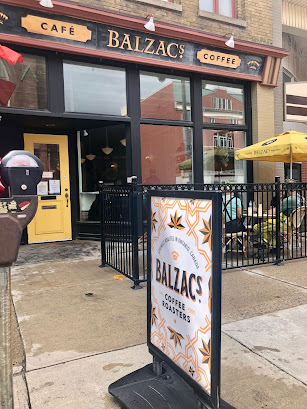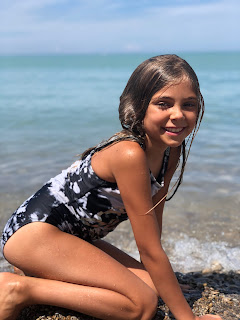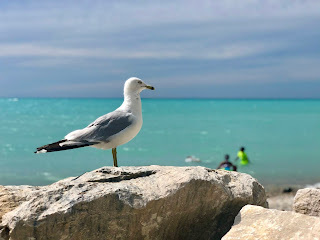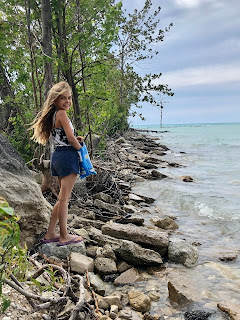Stratford is about one hour away from Lake Huron, so Saturday was a beach day!
The drive is easy, through a bunch of farm land.
I juts love seeing the crops and the farm houses along the way.
Welcome to Goderich, "The Prettiest Town in Canada."
FROM WIKIPEDIA:
As of the Canada 2016 Census, the population is 7,628 in a land area of 8.64 square kilometres. Located on the eastern shore of Lake Huron at the mouth of the Maitland River, Goderich faces the lake to the west and is notable for its sunsets. Some claim that Queen Elizabeth II once commented that Goderich was "the prettiest town in Canada" although no reigning monarch has ever visited Goderich. The town indicates that tourism is among its important industries. It has been named one of Ontario's best small towns by Comfort Life, a website for retirement living in Canada. The town participates yearly in the Communities in Bloom competition; and has won awards in many categories. In 2012, Goderich was a National Finalist in the competition, and was also part of the Circle of excellence.

The novelty here is its distinctive downtown, shaped around the courthouse.
It has an octagonal core and the streets radiate from the centre.
We were lucky to get the last minutes of the local market and do some shopping.
The centre street is in a circular shape.
Aerial photo of downtown Goderich from twitter. (Not my image)
Fly, my butterfly!
The beach is right there, a few minutes away from downtown.
What a "wow" effect when we first spotted it!
Lake Huron is about a three hours drive west of Toronto.
FROM WIKIPEDIA: By surface area, Lake Huron is the second-largest of the Great Lakes, with a surface area of 23,007 square miles (59,590 km2) – of which 9,103 square miles (23,580 km2) lies in Michigan; and 13,904 square miles (36,010 km2) lies in Ontario – making it the third-largest fresh water lake on Earth (or the fourth-largest lake, if the Caspian Sea is counted as a lake). By volume however, Lake Huron is only the third largest of the Great Lakes, being surpassed by Lake Michigan and Lake Superior. When measured at the low water datum, the lake contains a volume of 850 cubic miles (3,500 km3) and a shoreline length (including islands) of 3,827 mi (6,159 km). The surface of Lake Huron is 577 feet (176 m) above sea level. The lake's average depth is 32 fathoms 3 feet (195 ft (59 m)), while the maximum depth is 125 fathoms (750 ft (230 m)). It has a length of 206 statute miles (332 km; 179 nmi) and a greatest breadth of 183 statute miles (295 km; 159 nmi).
Cities with over 10,000 people on Lake Huron include Sarnia, the largest city on Lake Huron, and Saugeen Shores in Canada and Bay City, Port Huron, and Alpena in the United States.
The water is astonishing, a clear deep blue.
The water is cold but refreshing when is almost 30 degrees outside.
The beach is rocky.
There are play areas for kids along the long beach.
It didn't take long for a "gang" to be formed.
Peace in one picture.
Juju and I took a walk to the end of the beach area where people hang out.
We saw a contrast on the other side, completely empty but full of amazing nature.
You can drive or climb up the cliff to the light house.
FROM: https://www.lighthousefriends.com/light.asp?ID=1043
The harbour at Goderich was originally just the mouth of the Menesetung (Maitland) River, but in the 1830s, the Canada Company constructed two stone-filled wooden piers to provide protection for the anchorage.
Goderich is the oldest Canadian light station on Lake Huron and first consisted of a pair of range lights established in the early 1830s. A contract for the erection of the current lighthouse was entered into in 1845 and called for the tower to be completed by July 1, 1846. Thomas Mercer Jones, a powerful land magnate with the Canada Company, sold the needed parcel of land overlooking the harbour to Queen Victoria.
Adam MacVicar, a stone mason born in Edinburgh Scotland, worked on the construction of the Welland Canal after immigrating to Canada in the early 1800s. When that work was done, he relocated to Goderich and helped build the lighthouse in 1846. The square tower was constructed of evenly-coursed stone and features string courses between the first and second storey and just below the gallery. Though the tower stands just twenty feet tall to its lantern room, its light has a focal plane of 150 feet above Lake Huron. In November 1846, severe gales did considerable injury to the lantern. Some immediate repairs were made, and additional work was done when the lighting apparatus was placed in the lighthouse in 1847.

Photo by Sofia.
This incredible beach day ended back in Stratford with a delicious dinner at Revival House.
The food was good, but the atmosphere in a former church is what makes this place fun for us.
















































